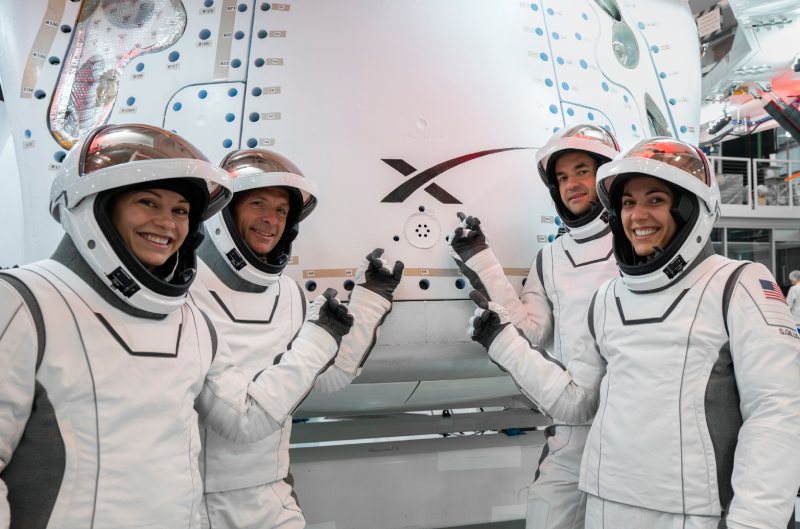The eagerly anticipated spacesuits from SpaceX have finally been revealed. They will be utilized on a future commercial space mission.
On May 4, the corporation posted the extravehicular activity (EVA) suit’s design on its website and social media accounts. Although it is designed to be used on spacewalks, the suit is based on the pressure suits that astronauts already wear on Crew Dragon flights.
New joint designs that maintain mobility under pressure, enhanced heat management, and an upgraded helmet with an external coating that functions as a sun visor along with a camera and heads-up display that provides information on the suit’s status during the spacewalk are all part of the suit upgrades. The suits’ life support system is supplied by umbilicals.
The Polaris Dawn mission, a Crew Dragon private spaceflight that is a component of the Polaris program of missions supported by billionaire Jared Isaacman, will be the first mission on which the suits will be worn. Along with Kidd Poteet, Sarah Gillis, and Anna Menon, he will fly on that mission. Because Crew Dragon does not have an airlock, all four will have to wear the suits throughout the spacewalk.
Gillis stated that the spacewalk would take roughly two hours, including the time needed to pressurize the cabin before it began and after. A “skywalker,” a device with handholds and interfaces to help them open the front hatch, will be used by two individuals to depart the capsule.
To gather information on the effectiveness of the EVA suits, the spacewalkers will traverse a “test matrix.” “We’re examining movement in this microgravity setting and the suit’s functionality,” the spokesperson stated. The test questions will be step-by-step for the duration of the exterior of the spaceship.
The crew dragon capsule was fully tested on the ground, including a test in which it was placed in a vacuum chamber with four “spacesuit simulators” inside and the cabin depressurized. According to Stu Keech, vice president of Dragon at SpaceX, “that all worked as expected.” That is comparable to Crew Dragon’s unmanned Demo-1 mission in 2019.
Dragon itself had to be modified in order to complete the spacewalk. For example, a repressuization system had to be installed in order to restore cabin pressure, and certain materials had to be changed because of their outgassing characteristics. Gillis stated, “When you see pictures of us sitting in the spacecraft, the interior is going to look a little different.”
The suits will also serve as the pressure suits that crew dragon missions typically wear during launch and return. SpaceX intends to eventually combine the two suits into a single one. Based on lessons acquired during the development of the EVA suits, the company has already made some modifications to pressure suits, which were first used on the Crew-6 mission.
This suit is intended to be our initial design for the EVA suit, and as we move forward and gain more knowledge, we will continue to make block upgrades, just like we do with all of our SpaceX products.
Plans for Polaris Dawn
A major component of the impending Polaris Dawn mission is the spacewalk, and the spacesuit development has been a driving force behind the flight’s multiple delays since it was originally scheduled for late 2022.
Now set for early summer, SpaceX expressed confidence that the timetable will hold for Polaris Dawn. “The next significant project for the Dragon program is Polaris Dawn,” stated Keech. “At this time, the entire team is working toward an early summer launch date.”
The Crew Dragon spacecraft will be launched into an elliptical orbit of 190 by 1,200 kilometers by the Falcon 9 rocket carrying out the Polaris Dawn mission. After that, the spacecraft will reach its apogee of 1,400 kilometers, which would be the highest point for a crewed mission since 1972’s Apollo 17.
Before descending to 700 kilometers, Dragon will stay at that apogee for roughly seven orbits to gather information on the elevated radiation environment. The mission will carry out the EVA at that height. According to Isaacman, the mission will stay in orbit for five days, carrying out tests and evaluating the spacecraft’s capacity for communication via SpaceX’s Starlink network.
There are additional dangers associated with this flight profile because of the spacewalk and higher altitude. According to Keech, SpaceX assessed the risk of radiation and the impact of micrometeorites and orbital debris on this flight profile. He declared, “For both of those, the Polaris Dawn mission will be within the risk that we accept for a six-month ISS mission.” “You have to expand the envelope and do it methodically, but we want to make sure we’re not taking unnecessary risks.”


